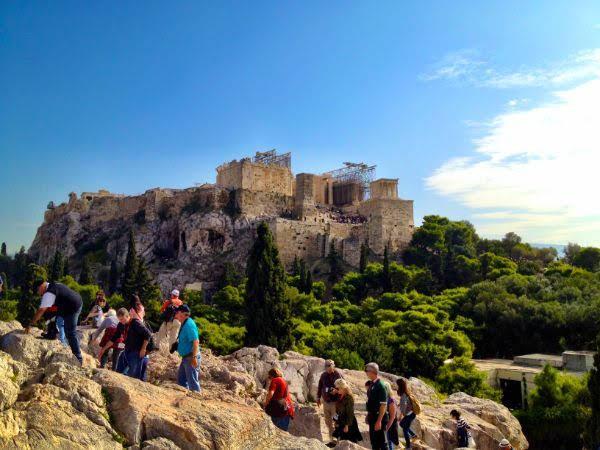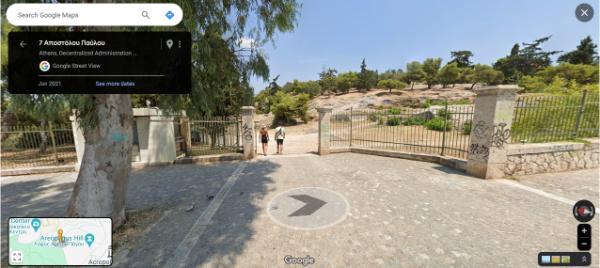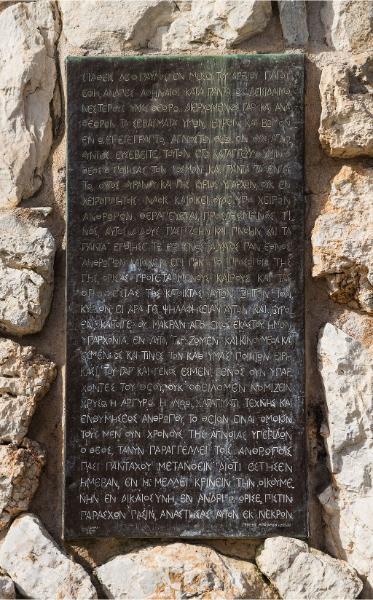The Areopagus Hill (Areios Pagos or Mars Hill) is a limestone outcrop in central Athens, just below the entrance of the Acropolis and above the Agora. The site holds immense historical significance for hosting the prestigious high court of pre-democratic Athens. Moreover, it is renowned as the setting of Apostle Paul’s Areopagus Sermon. Today, the hill is a favorite hangout for tourists and locals alike, who gather there to enjoy a hike on its forested slopes and the stunning, panoramic view from its top. In this post, you will find everything you might want to know about this eminent Athenian hill.

Affiliation disclosure: By purchasing goods or services via the links contained in this post, I may be earning a small commission from the seller's profit, without you being charged any extra penny. You will be thus greatly helping me to maintain and keep enriching this website. Thanks!
Accommodation and Activities in Athens
Stay22 is a handy tool that lets you search for and compare stays and experiences across multiple platforms on the same neat, interactive map. Hover over the listings to see the details. Click on the top-right settings icon to adjust your preferences; switch between hotels, experiences, or restaurants; and activate clever map overlays displaying information like transit lines or concentrations of sights. Click on the Show List button for the listings to appear in a list format. Booking via this map, I will be earning a small cut of the platform's profit without you being charged any extra penny. You will be thus greatly helping me to maintain and keep enriching this website. Thanks!
Contents
Description
The Areopagus Hill is a rocky outcropping jutting out from the northwestern slope of the Acropolis, between the three pedestrian streets of Apostolou Pavlou, Theorias, and Polygnotou. The surrounding slope features numerous hiking trails amid pines, cypresses, and other vegetation. The top of the hill has an elevation of 115 meters. It faces out to Philopappos and Pnyx hills to the southwest, the Propylaea of the Acropolis to the southeast, and the ancient Agora followed by the vast Athenian metropolis right below its northern foot.

How to get to Areopagus Hill
The Areopagus Hill is accessible from all around its periphery. The most common and easy approach reaches it via a metallic staircase installed by its southern side, near the Acropolis’s entrance, which is a 15-minute walk from the closest subway station of Acropolis.

Another, slightly longer and steeper approach comes from Thissio Station. Walk south along Apostolou Pavlou Street for about half a kilometer, past the park and the square, until you see a gate through the fence on your left-hand side (location). Enter and climb straight up the slope to the top.

From Monastiraki Station comes the shortest but steepest way. You will have to go south and meander a bit through the backstreets and up the steps until you reach Theorias Street below the Acropolis. Turn right and follow it to the Acropolis’s entrance and the staircase to the Areopagus.
This is the hilltop location.
What to see and do on Areopagus Hill
The main reason for visiting the Areopagus Hill is the view, especially for sunset or sunrise. The rock top offers a panoramic vista of the mountain-girdled northern half of the Athenian metropolitan jungle and the closest view of the Acropolis you can get from anywhere.


Additionally, you can enjoy a pleasant hike on the hill’s shaded slopes and discover the various ruins scattered throughout. By the western foot, check out the Sanctuary of Pan and the Fountain of Callirhoe. Beside the staircase south of the rock, there is a plaque with Apostle Paul’s sermon.
The site is also an excellent outdoor socializing space. Local and international youth flock to the top at night for beers over the sea of lights below.

Opening Hours & Entrance Fee
The Areopagus Hill is open and free to visit 24/7.
Name
Areopagus is a Latinized compounding of the Greek Areios Pagos (Άρειος Πάγος), which means the rock of Mars. It is called Mars Hill because, according to mythology, it was the site where the Greek gods tried their fellow Mars (Ares) for the murder of Poseidon’s son Halirrhothius.
An alternative mythological theory tells us that the hill’s name comes from Ares Erinyes: the chthonic goddesses of punishment and vengeance commonly referred to in English as the Furies.
History of Areopagus Hill
The Hill of Areopagus must have held distinctive religious significance since the early settlement of Athens. Some beehive tombs and carved graves discovered on the hill’s northern slope date to the early Mycenean era and are regarded as the oldest cemetery of Athens.
At an unknown later date, a council of aristocrats and former archons (magistrates) began convening on the hilltop to deliberate on matters of law, justice, and morality. The Areopagus Council evolved to become one of the city’s most influential and highly esteemed governing bodies. Among other, political and religious judicial functions, it was primarily responsible for handling appeals to serious criminal cases such as homicide and arson of olive trees (yes, that was a grave crime in ancient Athens as olive oil trading was what the city owed its prosperity to). Besides the mythical trial of Ares the god of war and the fictional trial of matricide Orestes in Aeschylus’s paragon play The Eumenides, the most notable historical trial adjudicated by the Areopagus was the one of first-class prostitute Phryne for impiety. She is said to have been acquitted after stripping for the judges.

Following rounds of reforms by Solon, Cleisthenes, and Ephialtes, the Areopagus Council gradually ceded its authority to the new democratic institutions. It continued to operate in diminished capacity throughout the Classical and Hellenistic periods. Its power was briefly reinstated during the Roman times before Christianity brought about its final demise.
The Areopagus Hill is additionally famous as the site where Apostle Paul preached during his visit to Athens in about 51 AD. His Areopagus sermon is recounted in Acts 17:16–34 of the Bible. In reality, the record mentions that Paul spoke before the Areopagus Council—which was by then convening in a different location—rather than on Areopagus Hill. His words didn’t prove as successful at converting the Athenians as the later Christians’ swords did. He gained but two followers: a woman named Damaris and Dionysius the Areopagite, a council member who would go on to become the first bishop of Athens.

Photo Gallery
View (and if you want use) all my photographs from Areopagus Hill.
